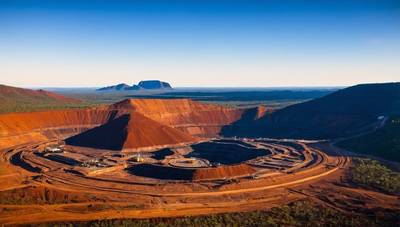The massive Simandou iron ore mine could end Australia's golden age of iron ore, or it can start a new one. Russell
It is overused to the point of being meaningless. But the Simandou mine, located in Guinea, West Africa is a game changer.
It is expected that the full 120 million tons of cargo per year capacity will be reached fairly quickly.
The four Simandou blocks are impressive for their size and infrastructure challenges. They boast a 620-kilometre rail line (384-mile) as well as a new port that has dedicated vessels to transship bulk carriers offshore.
Simandou, however, is not just a technical marvel. It will also meet about 10% of China's annual seaborne imports, which are the largest in the world. China takes around 75% of all seaborne iron ore.
Simandou, a Chinese-led venture, is dominated by Chinese companies, including Baosteel, while 25% of production is held by Rio Tinto – the world’s largest iron ore mining company.
Simandou's production could theoretically be sold worldwide, but in reality it will likely all go to China.
The project will also produce iron ore with a 65.3% iron content. This is better than what Rio and its competitors currently mine in Western Australia - the region that produces most iron ore.
As Chinese steel mills try to decarbonise their production, high grade iron ore could be more in demand in the coming years. This is a necessity given that steel production represents about 8% worldwide of carbon emissions.
Simandou's ore is of a quality that allows it to be directly fed into the electric arc furnaces. These furnaces produce steel at a much lower emission level than traditional oxygen furnaces which use large quantities of coal.
Who will be pushed out of China by Simandou ore?
This assumes, of course, that China's output of steel remains at the same level as it has been since 2019, which is around 1 billion tons per year.
Even if the major iron ore exporters Australia and Brazil don't replace their existing mines, there will still be some supply loss.
Iron ores with lower grades and high costs will likely be the obvious candidates. It's possible that producers will reduce production over time, allowing mines nearing their end-of-life earlier than expected.
It's bad news indeed for some miners in Western Australia. A combination of higher-grade ore, stagnant Chinese demand and increased Guinean supply will probably put downward pressure on the prices.
NEW INVESTMENT
Australia's iron ore miners and government have enjoyed a good run for most of the last decade. They are reaping the rewards of building large, efficient mines, and logistic solutions.
Iron ore is still a profitable product, even at its current price of $108 per ton. The cost to produce a ton of iron ore and transport it to a Western Australia port is about $23.
It could be argued, with the arrival of Simandou's high-grade ore and the need to reduce carbon in steel production, that Australia's golden era of iron ore has come to an end.
It could also be the catalyst for Australia to start a new investment spree to add value to its iron-ore bounty.
Australia may be better placed than other countries if the assumption is made that manufacturers around the world will increasingly switch to green steel.
For green steel, you'll need cheap iron ore as well as large quantities of renewable energy.
Australia has low-cost ore, and it is capable of producing enough renewable energy. The main source will be solar power with battery storage.
Green hydrogen is made from renewable energy and used to convert iron ore to direct reduced iron (DRI), or hot briquetted Iron (HBI).
DRI and HBI are both used in EAFs to produce steel.
It will take both federal and state government support to get any plan to beneficiate ore in the United States moving.
The recent announcement by the federal government of a package worth A$2.4 billion (about A$1.5 billion) to support steel production at Whyalla, in South Australia's state, was a positive sign.
The funding includes a $1 billion fund for green iron investments to support new projects and upgrade the existing steelworks in Whyalla.
This is a good start, but there's still a lot more to do if Australia's success story with iron ore is to continue.
These are the views of the columnist, who is also an author. (Editing by Himani Sakar)
(source: Reuters)





